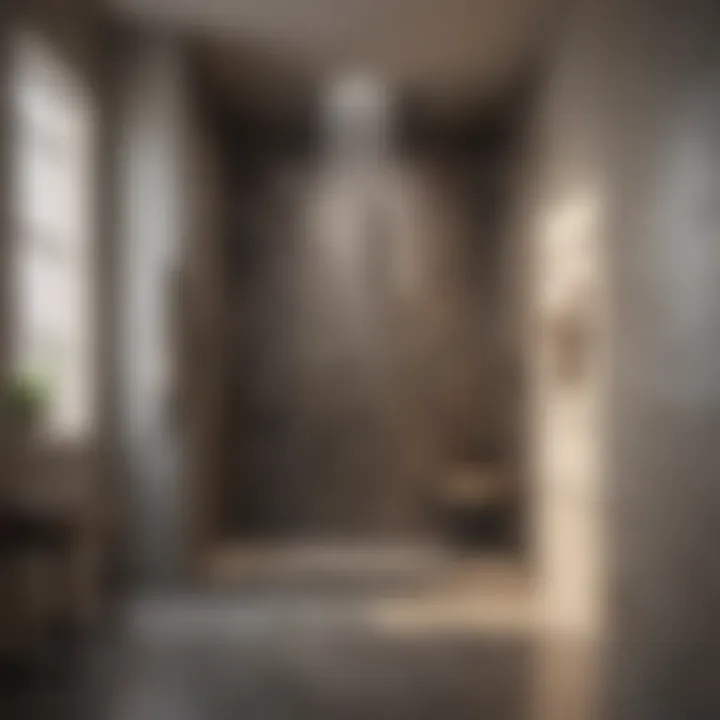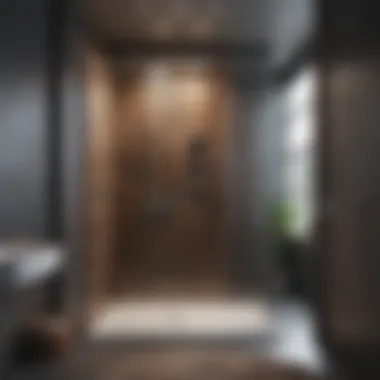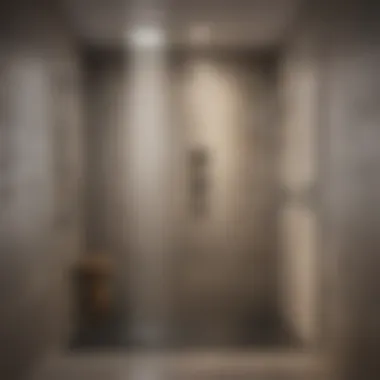Maximizing Space with Doorless Showers in Small Bathrooms


Intro
In contemporary bathroom design, doorless showers have gained attention, particularly for their appeal in small spaces. This concept breaks traditional barriers, merging functionality with style. Homeowners and designers alike recognize that optimizing small bathrooms is not just about practicality but also about creating an inviting atmosphere. The growing trend emphasizes spaces that feel open and airy while ensuring that they remain functional and user-friendly.
The shift towards doorless showers can be attributed to several factors, including modern lifestyles and aesthetic preferences. Maintaining cleanliness and providing a sense of spaciousness are key benefits that make this design choice enticing for many. However, it is essential to consider various elements, including design styles and color palettes, to create a coherent look that matches the home's overall aesthetic. This article explores the advantages and considerations of doorless showers, ensuring readers gain a comprehensive understanding of why this trend is worthy of attention.
Prelims to Doorless Showers
In recent years, the concept of doorless showers has gained considerable attention, especially among homeowners looking for innovative solutions for their limited bathroom spaces. The doorless design represents more than just a trend; it symbolizes a shift toward creating open, accessible, and visually appealing environments that cater to modern living. Understanding the intricacies of this design choice is critical for homeowners and designers alike.
Definition and Concept
A doorless shower is defined as a shower stall that does not include a door or traditional enclosure. This design choice facilitates an open bathroom layout, making the area feel larger and more inviting. The absence of a door eliminates physical barriers, creating an unobstructed flow that contributes to a sense of freedom and flexibility.
The concept emphasizes seamless integration with the overall bathroom design. Typically, doorless showers feature a low or curbless entry which enhances accessibility for people of all ages. Moreover, they often include glass panels or partitions that offer a hint of separation, while still allowing light and sightlines to flow unobstructed.
Historical Context
Historically, the shower has evolved significantly from being just a utilitarian space. In the past, bathrooms were often enclosed, reflecting the norms of privacy and modesty. However, as modern design principles emerged, there was a gradual shift towards more open and airy spaces. This change became particularly pronounced in the late 20th century and has continued into the 21st century.
The rise of minimalist design further propelled the doorless shower into the spotlight. As designers began to explore practicality alongside aesthetics, doorless showers emerged as a solution that addresses both functionality and style. They represent a departure from traditional constraints, allowing homeowners to maximize small spaces without sacrificing elegance.
In essence, the doorless shower is a culmination of various design philosophies that prioritize openness and accessibility. As urban living spaces become more compact, the necessity and relevance of doorless showers will likely continue to grow.
Advantages of Doorless Showers
The concept of doorless showers offers an array of advantages that make them particularly appealing for small bathrooms. These advantages not only contribute to functionality but also enhance the overall atmosphere and aesthetic of the space. In this section, we will delve into the specifics that highlight the benefits of doorless showers, focusing on how they optimize space, improve accessibility, enhance aesthetics, and simplify maintenance.
Space Optimization
One of the most significant advantages of doorless showers is effective space optimization. In a compact bathroom, every square inch is valuable. A doorless design eliminates the need for swinging or sliding doors, which can consume vital space and make the room feel even smaller.
Moreover, without traditional barriers, the shower area visually merges with the rest of the bathroom. This openness can create the illusion of a larger space and improve the flow of movement within the room. Here are some key points regarding this aspect:
- Unobstructed Flow: Doorless showers enable an uninterrupted flow between fixtures, reducing visual clutter.
- Flexible Layout: You can experiment with various layouts without worrying about door placement, thereby allowing for creative and functional designs.
- Enhanced Light: A barrier-free shower can help natural light to distribute evenly across the space, brightening the room and contributing to an airy feeling.
Improved Accessibility
An important factor in any bathroom design is accessibility, and doorless showers excel in this area. By removing doors, they provide easier access for individuals of all ages and abilities. This design is particularly beneficial for:
- Elderly Individuals: Seniors may find it challenging to maneuver around traditional shower doors. Doorless showers allow for safe and straightforward entrance and exit, reducing the risk of slips and falls.
- Individuals with Disabilities: Those using wheelchairs or mobility aids benefit greatly from the open layout. It creates a seamless transition from the bathroom floor into the shower area.
- Parents and Caregivers: Assisting children or others in the shower is more practical in a doorless design, as there is no hassle of opening or managing a door.
Enhanced Aesthetics
Doorless showers provide a fresh and modern look, enhancing the overall aesthetics of small bathrooms. They often become a focal point, adding style without overpowering the decor. Elements of aesthetic enhancement include:
- Minimalist Design: The absence of a door contributes to a sleek, uncluttered appearance, which aligns well with contemporary design trends.
- Customization: Homeowners can experiment with a variety of materials and finishes, allowing for personal expression in their interiors.
- Visual Continuity: Using the same materials for the shower floor and adjacent areas promotes visual continuity and helps unify the space, creating an elegant look.
Ease of Maintenance
Maintenance is another significant consideration when it comes to bathrooms. Doorless showers often require less effort to keep clean compared to traditional showers. This is due to the following reasons:
- Fewer Fixtures: Without doors, there are fewer surfaces to clean, which saves time.
- Improved Airflow: Doorless designs facilitate airflow, reducing moisture buildup. This can help mitigate mold and mildew growth, making the space easier to maintain.
- Simple Access: Cleaning the entire shower area is straightforward as there are no barriers to work around.
Design Considerations for Small Bathrooms
Designing a small bathroom with a doorless shower involves careful thought and consideration. The limited space presents unique challenges, yet it also opens up opportunities for creating a functional and stylish environment. The right design elements can optimize the available space while ensuring the area remains accessible and visually appealing. Effective design choices nurture an atmosphere where functionality meets aesthetics, which is essential for any small bathroom renovation. Here, we delve into specific factors that come into play when planning a doorless shower in a constrained setting.
Sizing and Layout


When dealing with a small bathroom, it is vital to maximize every inch of space. Sizing and layout are critical factors that determine how well a doorless shower integrates into the existing environment. It is essential to measure the bathroom accurately. This involves noting the dimensions of walls, fixtures, and existing plumbing. A shower area should ideally occupy a space that feels open yet separated enough to maintain a sense of privacy.
Positioning the doorless shower can also affect how light enters the space. For example, if the shower is placed against a window, it can enhance brightness but may cause issues with privacy. Consideration of how water flows and whether the layout allows proper drainage is also crucial. Implementing an open-concept design can improve the perception of space, making a small bathroom appear larger than it is.
Water Considerations
Water management is another prominent aspect when integrating a doorless shower into a small bathroom. Understanding water considerations helps ensure that the setup is both functional and effective. This includes assessing the current plumbing system, water pressure, and drainage capabilities.
Proper drainage is often overlooked but is vital in preventing water spillage outside the shower area. Linear drains are popular for doorless showers. They provide an efficient way to manage water flow while keeping the design sleek and modern.
Additionally, controlling water pressure helps maintain comfort. Weak water pressure can minimize the shower experience, while excessively strong pressure can be overwhelming in a smaller area. Homeowners should think about shower heads that offer adjustable settings, enhancing versatility in a confined space.
Lighting Choices
Lighting is essential for creating ambiance and enhancing functionality in a small bathroom, particularly one featuring a doorless shower. Lighting choices involve selecting the right fixtures to illuminate the space without overwhelming it. Options such as recessed lighting or wall sconces can create a warm environment while ensuring every detail is visible.
Additionally, consider incorporating natural light, if possible. A strategically placed window or skylight can brighten the area, making it feel more inviting. This not only elevates the aesthetic appeal but can also influence the mood and perceived size of the space.
Material Choices for Doorless Showers
When selecting materials for doorless showers, several important factors come into play. The choice of materials affects not only the functionality and durability of the shower but also contributes to the overall aesthetic and vibe of the bathroom. Proper material selection can make maintenance easier, help prevent water-related damage, and enhance the sensory experience of the space. Choosing the right materials can even influence the perception of space in a small bathroom, making it feel more open and inviting.
Suitable Flooring Options
Flooring is a critical element in doorless shower design. Waterproof and durable materials are essential to prevent water damage and ensure safety. Some popular options include:
- Ceramic Tiles: Versatile and available in a variety of styles and colors, ceramic tiles offer durability and slip resistance.
- Vinyl Flooring: Often budget-friendly, vinyl flooring is water-resistant and can mimic other materials, such as wood or stone, without the high cost.
- Natural Stone: Options like slate or travertine provide a luxurious feel. However, they may require more upkeep to maintain their beauty and prevent slipping.
Each of these flooring types has unique benefits. For instance, ceramic and natural stone can add a sophisticated touch, but they can also be higher in cost and may demand extra effort in maintenance. Vinyl is practical for those on a budget and simple to clean.
Wall Treatments
Walls in a doorless shower must also be chosen with care to prevent moisture issues and promote a harmonious look. Typical materials for wall treatments include:
- Waterproof Paint: A cost-effective way to protect wall surfaces while allowing for a burst of color.
- Shower Panels: Made of acrylic or fiberglass, these panels are easy to install, maintain, and prevent mold growth.
- Tile: Like the flooring, wall tiles can provide visual interest and can be easily cleaned and maintained. Larger tiles might reduce grout lines, making maintenance simpler.
Selecting wall treatments should reflect both practical needs and aesthetic preferences. The chosen material should coordinate with the flooring while ensuring that the moisture levels remain manageable.
Integration with Bathroom Aesthetics
The integration of doorless showers within bathroom aesthetics cannot be understated. This element plays a significant role in how the space feels and appears. A doorless shower can enhance the overall look of a bathroom, making it feel more open and inviting. It creates a seamless flow, giving the illusion of a larger area. This is particularly beneficial for small bathrooms, which often suffer from tight spaces.
Enhancing Cohesion
Achieving cohesion in design is essential to create an inviting bathroom environment. A doorless shower can contribute to this goal by harmonizing with the overall décor. Consider continuity in materials and colors throughout the space.
- Choose similar tiles: Using identical or complementary tiles for both the shower and surrounding wall can unify the design.
- Consistent fixtures: Employing matching faucets and showerheads ensures that the overall aesthetic is cohesive.
- Uninterrupted sight lines: The absence of a door allows for a continuous visual journey from one area to another, enhancing the sense of space.
In this way, a doorless shower integrates naturally with other design elements, reinforcing a cohesive atmosphere without any visual barriers.
Color Schemes
The choice of color scheme plays a crucial part in integrating doorless showers into bathroom aesthetics. Colors can influence mood, perception, and the overall feel of the space.
- Light colors: These can make a small bathroom feel larger. Light hues like whites, pastels, or soft grays are effective at reflecting light, which further enhances the feeling of openness.
- Accent colors: Introducing deeper or darker tones can highlight certain features such as fixtures or decorative elements without overwhelming the serene feel of the space.
- Monochromatic palettes: Sticking to a single color with varied shades can also create a sophisticated and modern appearance.
Implementing an appropriate color scheme complements the design of a doorless shower while remaining visually appealing.
"A cohesive design amplifies the serenity and sophistication of your bathroom, making even the smallest spaces feel luxurious."
Overall, the integration of doorless showers into bathroom aesthetics requires careful consideration of materials, fixtures, and colors. By focusing on cohesion and color, homeowners can enhance both functionality and visual appeal in their small bathrooms.


Plumbing Considerations
Understanding plumbing considerations is vital when planning a doorless shower, especially in small bathrooms where every detail counts. Proper plumbing ensures functionality while enhancing the overall experience of using the shower. Attention to plumbing aspects not only affects the operation of the shower but also contributes to the aesthetics and comfort of the space.
Drain Placement
Drain placement is critical in any shower setup, but it becomes even more essential in a doorless design. Unlike traditional showers that have defined boundaries, doorless showers might face issues with water flow and drainage patterns. Ideally, the drain should be located in a position that facilitates the swift removal of water. Typically, a central location is recommended; this allows water to flow naturally toward the drain, minimizing the risk of water pooling.
When considering drain placement, bear in mind the slope of the shower floor. This slope must direct water towards the drain efficiently. Furthermore, establishing a proper height for the drain is equally significant. Too high, and water may build up; too low, and it may cause discomfort when stepping in or out of the shower. Utilizing linear drains can also be an effective solution for doorless showers, offering an unobtrusive design while maintaining excellent functionality.
Water Pressure Needs
Water pressure is another crucial consideration for doorless showers. The nature of the open design requires a balanced water supply to ensure a satisfying shower experience. Insufficient water pressure can lead to poor shower performance, making the experience less enjoyable.
To meet the desired pressure levels, it may be necessary to invest in a quality showerhead that efficiently accommodates lower water pressure. Opting for models designed for low flow can also be beneficial, as they provide sufficient water coverage without exhausting resources. Furthermore, checking the home's overall plumbing system can help identify whether an upgrade or adjustments are needed to maintain optimal performance.
Proper plumbing is the backbone of a successful doorless shower, affecting both functionality and comfort in the space.
In summary, addressing drain placement and water pressure needs are fundamental to the planning phase of doorless showers. These considerations play a significant role in creating a sustainable and enjoyable bathing experience that aligns with modern design principles.
Environmental Impact
The shift towards doorless showers in small bathrooms is not just an aesthetic choice. It holds significant weight in terms of environmental impact. Discussing this topic is important due to the essential role that modern living plays in sustainability. In the context of bathroom design, focusing on environmental concerns can lead to better decision-making for both homeowners and the planet.
Water Efficiency
Doorless showers contribute notably to water efficiency. Traditional showers often lead to some wasted water, especially when users adjust the temperature prior to entering. In contrast, doorless designs allow for quicker access, which can reduce the amount of water wasted during typical shower routines. The open layout means fewer structural barriers, encouraging more mindful usage.
Using water-saving fixtures, such as low-flow showerheads, can further enhance the efficiency of doorless showers. These fixtures limit the water flow without compromising the shower experience. The combination of doorless design and modern fixtures makes for an environmentally friendly option that can meet the needs of discerning homeowners.
Sustainable Materials
Selecting sustainable materials is another critical consideration when implementing doorless showers. Homeowners now prioritize options that have a lower environmental footprint. Materials like recycled glass or sustainably sourced wood not only enhance the shower's aesthetic but also contribute positively to the environment. Sustainable choices promote a healthier ecosystem.
Furthermore, the life cycle of materials should be considered. Opting for products that are durable and long-lasting aligns with sustainable values. This reduces the frequency of replacements, lowering waste. Many manufacturers now offer certified eco-friendly products, making it easier for homeowners to choose wisely.
"Choosing sustainable materials is not just good for the planet; it also enriches the home environment."
Maintenance Challenges
The adoption of doorless showers, while increasingly popular in small bathrooms, carries specific maintenance challenges that warrant careful attention. Unlike traditional showers with doors, doorless designs expose fixtures and surfaces to more visibility, necessitating diligent upkeep. This section will examine the significance of maintenance related to doorless showers, addressing the cleaning techniques required and methods to prevent mold and mildew.
Cleaning Techniques
Cleaning a doorless shower requires a structured approach to effectively manage soap scum, grime, and water stains. Here are key techniques:
- Regular Schedules: Establish a consistent cleaning routine. This ensures surfaces remain free from build-up, reducing the need for intensive cleaning sessions.
- Gentle Cleaners: Opt for non-abrasive and eco-friendly cleaners. Harsh chemicals can damage the surfaces and lead to environmental concerns.
- Soft Brushes and Cloths: Using soft brushes or microfiber cloths helps to eliminate dirt without scratching materials. Pay attention to corners and crevices where grime may accumulate.
- Squeegee Use: After each use of the shower, a quick run of a squeegee over the walls reduces water spots and soap scum chances.
These practices not only maintain hygiene but also prolong the life of the materials used in the shower.
Preventing Mold and Mildew
The open design of doorless showers may make them more susceptible to mold and mildew. Preventative measures can significantly minimize these risks:
- Ventilation: Proper air circulation is crucial. Ensure the bathroom has adequate ventilation, possibly through the installation of exhaust fans or windows that can be opened.
- Moisture Control: Utilize a dehumidifier if necessary. Controlling humidity levels helps to discourage mold growth.
- Sealant Application: Check the grout and sealant regularly. Reapply sealants as needed to create barriers against moisture penetration.
- Prompt Drying: After showering, encourage drying of the surfaces. Towels can be used to wipe down surfaces to eliminate standing water.
Regular maintenance not only enhances the appearance of your shower but also safeguards against deterioration and hygiene issues.
By focusing on these maintenance challenges, homeowners can ensure their doorless showers remain functional and pleasing. The right cleaning techniques and preventative measures effectively mitigate common issues while supporting the desirable aesthetics that come with these modern designs.
Alternatives to Doorless Showers


In the context of small bathrooms, the concept of doorless showers represents a shift towards modern design and practicality. However, not everyone may find this option suitable due to various reasons, such as personal preference, layout constraints, or moisture management issues. Thus, exploring alternative solutions that offer similar benefits while addressing these concerns is crucial. This section discusses two popular options: partial dividers and curtains or screens. Each of these alternatives can provide a unique aesthetic and functional contribution to a small bathroom.
Partial Dividers
Partial dividers serve as an efficient alternative to completely enclosing a shower area. They can be made from various materials, such as glass, acrylic, or even decorative stone. The primary advantage of partial dividers is their ability to create a designated shower space without completely closing it off from the rest of the bathroom. This open yet defined style optimizes light flow, making the area feel larger.
Benefits of Partial Dividers:
- Space Efficiency: They help maintain the perception of space, essential in small bathrooms.
- Aesthetic Appeal: Can be customized to match the bathroom's design, adding a unique touch.
- Moisture Control: While they do not completely eliminate moisture, they can reduce splashes, helping to maintain the rest of the bathroom dry.
However, it’s important to consider the height and material of the divider. A shorter, glass divider may not contain water spray effectively, while a taller divider—though more efficient—could inhibit light flow. Balancing these elements is crucial for achieving the desired result.
Curtains and Screens
Another option for those seeking to maintain some level of enclosure in a shower is the use of curtains or screens. This choice offers flexibility and can be less expensive compared to building permanent structures. Curtains can be pulled back when not in use, providing an open feeling in the bathroom, while screens can be positioned as needed.
Advantages of Curtains and Screens:
- Versatile Design: Available in myriad colors, patterns, and materials, allowing for customizable aesthetics.
- Cost-Effective: Generally affordable and easily replaceable if styles change.
- Ease of Use: Simple to install and operate, making them a practical choice for many homeowners.
However, curtains require regular washing to prevent mildew buildup, and care should be taken when selecting water-resistant fabrics. Meanwhile, screens might require more space to swing open or adjust, which is a consideration in tight quarters.
Ultimately, choosing between partial dividers, curtains, or screens depends on individual needs and the overall design intent for the bathroom. Each option provides a level of openness valued in modern design while still maintaining some level of function. Allen to explore a blend of solutions may yield a highly personalized and effective result.
Future Trends in Bathroom Design
The modern bathroom is evolving rapidly, reflecting both functionality and style in increasingly compact spaces. In the discussion of doorless showers, it is crucial to consider future trends in bathroom design. These trends often emphasize comfort, aesthetic appeal, and smart innovations, making them relevant to homeowners looking to enhance their small bathroom spaces. By understanding these elements, it becomes clear that doorless showers can seamlessly blend into these future designs while addressing specific user needs.
Minimalism and Open Spaces
Minimalism continues to gain traction in bathroom design, characterized by clean lines, a lack of clutter, and a focus on essential elements. This trend aligns well with the concept of doorless showers, allowing for more open spaces that create a feeling of freedom and flow. When designing a small bathroom, reducing visual barriers is key. Doorless showers exemplify this by eliminating doors that can visually segment the space, thus contributing to a more expansive feel.
Key benefits of adopting minimalism include:
- Enhanced Light Flow: Open spaces allow natural light to travel freely, brightening the bathroom.
- Simplified Maintenance: Fewer items mean less cleaning and upkeep, appealing to busy homeowners.
- Easier Workflow: An uncluttered space facilitates movement, essential for smaller areas.
In practical terms, integrating a doorless shower in a minimalist bathroom can elevate the overall design, making it not only a functional element but also a central aesthetic feature.
Smart Shower Innovations
Advancements in technology are reshaping how we interact with our bathrooms. Smart shower innovations are at the forefront of this shift, introducing elements such as digital controls, water-saving features, and automated temperature settings. These innovations not only enhance user experience but also promote efficiency in water usage, a critical concern for many homeowners today.
Consider the following aspects of smart shower technologies:
- Digital Controls: Allow for precision in water temperature and pressure, providing a personalized showering experience.
- Water Monitoring: Systems that track water usage help homeowners manage bills and reduce waste.
- Remote Access: Some modern showers can be controlled via smartphone apps, creating convenience for users.
Incorporating these smart technologies into a doorless shower can significantly improve the overall functionality of the bathroom. Homeowners are increasingly looking for systems that combine efficiency with modern aesthetics, meeting the demands of contemporary living.
"Innovative design does not only improve aesthetics but also makes homes more functional and sustainable."
Ending
The topic of doorless showers holds significant relevance in today’s quest for functional and modern bathroom designs, particularly for small spaces. This article explored various aspects that underpin the increasing preference for these shower styles. The importance of integrating doorless showers is amplified by their ability to maximize spatial dynamics while offering a sleek, minimalist aesthetic. These features share a common ground with the contemporary trends, creating seamless connections within the home environment.
Summary of Insights
Throughout this discussion, several key insights emerged:
- Space Optimization: Doorless showers eliminate the physical barrier that traditional doors create, allowing for a more open and airy feel in small bathrooms. This feature not only contributes to enhancing the perceived space but also supports fluid movement within the room.
- Accessibility: The absence of a door provides easier access for individuals with mobility challenges, making these showers an accommodating option.
- Maintenance: While cleaning is generally straightforward, special attention must be given to materials used in these showers to ensure ease of upkeep and prevent issues like mold.
These insights underline the potential of doorless showers to enhance both functionality and style in compact spaces.
Final Recommendations
To harness the benefits discussed, homeowners are advised to consider the following:
- Choose the Right Materials: Opt for water-resistant materials that are easy to clean. Options like porcelain tiles or glass panels are often recommended for their durability and aesthetic appeal.
- Plan the Layout Wisely: Ensure that plumbing and drainage are meticulously planned. Correct placement is essential to avoid water pooling and creating maintenance headaches.
- Incorporate Natural Light: When possible, allow natural light into the bathroom to enhance the open feel. Skylights or larger windows can enrich the space.















